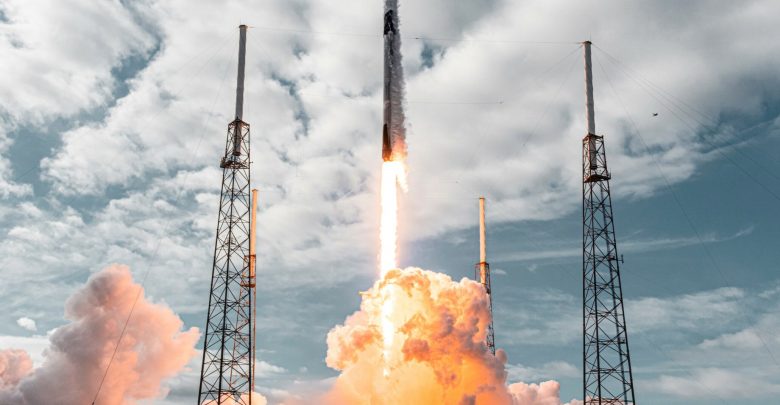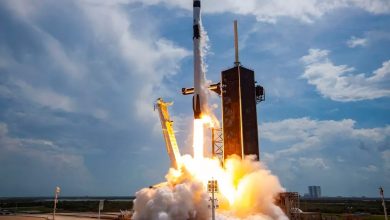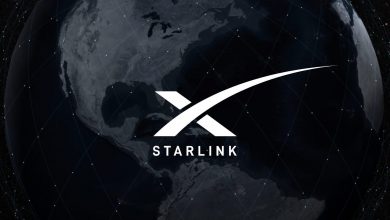
SpaceX successfully launched an ambitious rideshare mission using its Falcon 9 rocket which hoisted 143 small satellites, which is a new record for a single rocket into space before perfecting a landing at sea. The previous record was 104 satellites set by India in 2017.
The privately owned space transportation company deployed the satellites as part of its Smallsat Rideshare Program in a mission that departed Space Launch Complex 40 (SLC-40) at Cape Canaveral, Florida, at 10 a.m. ET on Sunday, January 24.
Liftoff! pic.twitter.com/js3zVM77rH
— SpaceX (@SpaceX) January 24, 2021
The two-stage Falcon 9 rocket lifted off Sunday morning (Jan. 24), soaring into a blue sky dotted with clouds at 10 a.m. EST from the Space Launch Complex 40 at Cape Canaveral Space Force Station in Florida a day after thick cloud cover prevented the rocket from leaving Earth..
The above YouTube video is the short version of the launch. For the full version completely detailed, click on this link
The 229-foot-tall (70-meter) Falcon 9 rocket soared toward the southeast from the launch pad at Cape Canaveral, then vectored its thrust to fly on a coast-hugging trajectory toward South Florida, before flying over Cuba, the Caribbean Sea, and Central America.
The unusual trajectory was similar to the track followed by a Falcon 9 launch in August 2020, which was the first launch since the 1960s from Florida’s Space Coast to head into a polar orbit.
The Transporter-1 mission carried 133 commercial and government spacecraft (including CubeSats, microsats, and orbital transfer vehicles) and 10 Starlink satellites for SpaceX’s internet-from-space initiative into orbit. Acting as a cosmic carpool, SpaceX sent the bevy of small satellites into space alongside 10 of its own Starlink internet satellites. The mission is expected to deposit the flat-paneled Starlink satellites in a unique polar orbit, which is a first for its broadband fleet that will help provide coverage to customers in Alaska and other polar regions.
The company also noted that the 10 Starlink satellites were the first in its rapidly growing constellation to deploy to a polar orbit.
SpaceX aimed to placed the satellites into an orbit roughly 326 miles (525 kilometers) in altitude, with an inclination of 97.5 degrees to the equator. The company confirmed an on-target orbital injection after the second burn of the Falcon 9’s upper stage engine, setting the stage for a carefully-choreographed payload deployment sequence that took more than a half-hour to complete.
The Transporter 1 mission broke the record number of satellites on a single launch, exceeding the 104 spacecraft launched on an Indian Polar Satellite Launch Vehicle in 2017.
The rocket powering today’s mission is also a frequent flier, marking its fifth flight on the Transporter-1 mission. Known as B1058, the booster first entered service in May 2020 when it launched two NASA astronauts, Bob Behnken and Doug Hurley into space as part of NASA’s first crewed mission under the agency’s Commercial Crew program, called Demo-2. The flight marked the first astronaut mission to the International Space Station to launch from U.S. soil since the retirement of the space shuttle program in 2011.
The booster, which is plastered with NASA’s iconic worm logo, also ferried a communications satellite for South Korea’s military, a batch of Starlink satellites and a Dragon cargo capsule to the space stationfor SpaceX’s 21st resupply mission in December.
Originally slated to blast off on Saturday 23rd morning, the complex Transporter 1 mission was delayed 24 hours due to poor weather conditions at the launch site. On Sunday, those rainy conditions were replaced by clouds and sunshine, allowing the Falcon 9 rocket and its record-setting payload to get off the ground right on time.
Following a successful lift off, the Falcon 9’s first stage landed on SpaceX’s drone ship “Of Course I Still Love You” in the Atlantic Ocean. The catch marked the 73rd recovery of a first-stage booster for SpaceX and the first catch of the year for the company’s main drone ship, after receiving some needed refurbishments. (SpaceX’s two other launches this year landed their first-stage boosters on a separate drone ship, “Just Read The Instructions.”)
A massive fleet of tiny satellites
For its fifth act, which came just over a month after its last flight, the veteran Falcon 9 acted as a space taxi service to deliver the 143 Transporter-1 mission satellites into orbit. The mission was the first in a dedicated series of rideshares as part of a program SpaceX created to help smaller satellites get into space by sharing a ride and reducing costs.
The company announced in 2019 that it would offer rides on its Falcon 9 rockets at certain intervals throughout the year and for $1 million per launch. Those flights can be booked through a dedicated website that SpaceX created.
Rideshares missions are not exactly new for SpaceX. The company has sent payloads to space for multiple companies, including a similar rideshare mission in 2018. That flight, dubbed SSO-A, delivered 64 satellites into low-Earth orbit, launching from SpaceX’s California launch pad in December 2018.
Since then, SpaceX has shared space with other payloads to space on a few of its Starlink missions. Those missions included small cubesat satellites for Planet and BlackSky. It also launched the Beresheet lunar lander into space for Israel in 2018.
Record rideshare launch challenges tracking capabilities, raises questions for regulators
U.S. military radars and optical sensors scattered around the world were ready to detect and track all 143 satellites after separation from the Falcon 9 rocket.
That data will be fed to the U.S. Space Force’s 18th Space Control Squadron at Vandenberg Air Force Base, California, where sophisticated computers and military personnel will generate datasets, or orbital elements, for each object and add them to the catalog of more than 27,000 human-made objects tracked in orbit.
The Space Force is responsible for maintaining the catalog of artificial space objects, and screening for potential collisions between satellites and space debris, which could generate even more junk in orbit.
“We’re in the business of space domain awareness,” said Lt. Col. Justin Sorice, commander of the 18th Sapce Control Squadron, in an interview with Spaceflight Now last year. “That means we want to understand what’s going on in the domain so that we can be responsible and we can alert owner-operators.
“We’re kind of like the lighthouse,” Sorice said. “We’re not the air traffic controllers, so I can’t tell other owner-operators from either the U.S. or other countries to move their satellites. But what we can do is give them plenty of warning.”
But it could take a while to sort identify each of the 143 satellites, along with debris generated from the Transporter-1 launch.
“Releasing so many objects on the same launch presents a huge challenge for the people that are tasked to track and identify those objects,” said Brian Weeden, director of program planning and technical advisor for the Secure World Foundation. “It’s really difficult for them to do that unless they have a lot of advance knowledge about how many payloads there are, when are they going to be deployed, what orbit are they deployed in, how are they going to be deployed? There are a lot of little nuances there that can help, but they have to know that information.”
SpaceX is “generally pretty good” about providing the Space Force with information about the orbits targeted by its missions, Weeden said. That helps radars and optical sensors know when and where to look to detect the new satellites.
“Imagine you’re the 18th Space Control Squadron, and you now see, let’s say, 100 things that are all roughly 10-centimeter cubes?” Weeden said. “How the heck do you know which is which?”
Falcon 9 launches carrying batches of 60 Starlink satellites at a time have become the norm, and SpaceX typically releases its orbital targets and deployment times. The process is more simple for a Starlink launch, where SpaceX owns all the satellites, than for a rideshare mission with numerous customers.
“If the satellite operator knows where it is, and can contact their satellite quickly after launch, this is not a huge problem,” Weeden said. “But if they can’t contact quickly after launch, and then they turn to the military for help in trying to find their satellites so they can talk to it, that’s where it becomes a real problem.”
SpaceX provided predicted orbital information to the space traffic management community before the Transporter-1 mission, but only for satellites and support hardware that would separate directly from the Falcon 9 upper stage, not the payloads riding on carrier vehicles, or space tugs, designed to deploy small satellites hours or days later.
“They’ll be tracking them relatively quickly,” Weeden said. “They won’t have them identified and catalogued for probably days, if not weeks.”
T.S. Kelso, an astrodynamicist who manages AGI’s Center for Space Standards and Innovation, agreed it could take weeks to identify and catalog all the objects from the Transporter-1 mission.
“I do think it is important to get all operators that are capable of independently tracking their satellites to publicly share their data, for the common benefit of all operators in Earth orbit,” Kelso wrote in an email to Spaceflight Now.
“I have been trying to get that message out, but with many new operators who are not familiar with the limitations of current legacy systems, we continue to see operators just assuming that tracking and identifying their satellites is a done deal, or believing that all they need to know is where their satellites are located,” said Kelso, who also runs the website CelesTrak.com.
Although SpaceX provides the space traffic management community with predicted orbital parameters before most of its launches, there’s no requirement for a launch or satellite company to do so.
SpaceX did not publicize the total number of satellites on the Transporter-1 mission until less than 24 hours before the first launch attempt, and the company has not released a comprehensive list of every satellite carried to orbit Sunday.
Many customers disclosed their participation in the Transporter-1 launch well in advance. Others announced they had payloads on the mission just days before liftoff, and some declined to publicly reveal their satellites were on the flight until after it launched.
“Interesting to see the varying amounts of transparency from the many companies involved in the Transporter-1 launch,” tweeted Jonathan McDowell, an astronomer who tracks space activity, shortly after Sunday’s launch. “Some have already tweeted about their successful deployments, and some have not even yet acknowledged that they were on the flight.”
Many of the satellites on the Transporter-1 mission have no way to change their orbit. AIM also carries no propulsion system, so there would be no way to steer clear of a collision, according to Russell.
Russell called for the U.S. government to “create policy” and for Congress to “make laws” setting safety requirements to limit the chances of in-space collisions.
“That doesn’t exist right now,” Russell said. “I think the process for getting this in place is moving, but it’s moving at a snail’s pace.”
The Federal Communications Commission decided last year not to immediately introduce any new major requirements for commercial satellite operators. The FCC discussed requiring commercial satellites above a certain altitude — where they might remain in orbit for decades — to have propulsion to maneuver and deorbit at the end of their missions.
“They did not fundamentally change the actual requirement because they got a huge amount of pushback from industry,” Weeden said. “So all of the serious changes got pushed to another round.”
The FCC licenses all satellites that transmit radio signals, giving it outsized influence over a large swath of the commercial space industry. Other agencies in the federal government’s disjointed space regulatory regime include the Federal Aviation Administration, which licenses commercial launches and re-entries, and NOAA in the Department of Commerce, which oversees commercial remote sensing satellites.
The FAA also reviews payloads flying on commercial space launches. Publicly available regulatory filings can give some hints about what payloads are flying in rideshare missions like Transporter-1, but they are often published months in advance of a launch.
In the rideshare launch business, payloads can be added or removed from a mission with little or no public notice.
Sensing explosive growth in the commercial space industry, the Obama administration started re-assessing the government’s regulatory approach to commercial spaceflight nearly a decade ago, but never implemented any significant changes.
The Trump administration issued a space policy directive in 2018 that would transition space traffic management responsibility from the military to the Department of Commerce. The Trump administration also directed the Commerce Department take on a “mission authorization” function, which would review, authorize and supervise commercial space activities that don’t fall under the regulatory authority of the FAA, the FCC, or NOAA.
“That’s not ideal,” Weeden said. “That is, I would say, about as light touch as you can possibly get, but it would at least put someone, a government agency, nominally responsible for looking at this stuff.”

A visualization of space debris in low Earth orbit. Credit: NASA
Congress would need to act to give the Commerce Department the mission authorization authority. But that is “probably not going to happen for a while,” Weeden said.
Until then, there is no specific federal agency empowered to look into issues like space debris mitigation or public disclosures about commercial space activity.
“This is why the FCC is involved because right now, since they regulate spectrum, that means they touch just about every single commercial satellite out there,” Weeden said. “So they’re really the only existing entity that already has regulatory authority over all these commercial activities.
“That is why right now they’re the vehicle for regulating these large constellations,” Weeden said. “But they’re probably not the ideal way to do that because they do spectrum. They don’t really do debris mitigation and this other stuff.”
Governments are required to provide the United Nations with basic information about the orbit and purpose of satellites under the Registration Convention. But that information is usually published well after a launch.
Space traffic management experts have also developed radio-frequency identification, or RFID, tags that could help identify satellites in orbit. But that, too, has gotten little traction beyond a few technical experiments.
“There’s a lot of interest and support for that from the technical community, but the Trump administration was not wiling to put any kind of requirements on companies like that,” Weeden said. “Unknown if the Biden administration will.”
Without regulatory requirements in place, government agencies urge commercial satellite operators to follow guidelines and “best practices” to avoid generating more space junk.
“But in the end these companies, in this case SpaceX, they’ve got a financial incentive to launch these small satellites, so they have to make their own decisions,” Russell said. “And they’re very, very tight-lipped about what they’re launching because they have individual agreements with different people.
“I think we need to take some action now to step up the process to get regulations in place where not only the private interests but the public interests can be met, and it’ll help everybody.”
Companies like Exolaunch reserved ports on the Transporter-1 payload stack, then divided that capacity among multiple small satellite customers. Spaceflight, based in Seattle, the Italian company D-Orbit, the Dutch small satellite launch broker Innovative Solutions in Space, Houston-based Nanoracks, and Maverick Space Systems of California all booked capacity on the Transporter-1 mission, then divvied their slots among their customers.

“When we launch more than one satellite on each port, we make the price even better for the customer,” Medvedeva said in a pre-launch interview with Spaceflight Now. “SpaceX sells a 200-kilogram port … I know few satellites which are 200 kilograms precisely, so if you are lighter than 200, there is a chance to add other payloads just to share the slot.”
There were eight nanosatellites launched Sunday for Kepler Communications, a Toronto-based company with plans to field a fleet of 140 small spacecraft for data relay and Internet of Things services. Kepler’s eight “GEN1” nanosatellites were built at the company’s own production facility in Toronto.
Kepler previously launched three prototype nanosatellites and the first two GEN1 satellites in September. The GEN1 satellites, based on a 6U-XL CubeSat bus, are production models with higher power and improved antennas to support Ku-band and narrowband communications capabilities, according to Kepler.
“We’re excited to continue our network deployment in response to the overwhelming global demand for our network capacity. As our network continues to grow, we move closer to recognizing Kepler’s vision of providing connectivity on and off the surface of the Earth,” said Mina Mitry, Kepler’s CEO, in a statement.
Eight Lemur-2 CubeSats from Spire Global were also on the launch. They join Spire’s fleet of smallsats providing aircraft and maritime tracking services, and collecting atmospheric data for use in weather forecasting.
Radar imaging satellites also received a boost Sunday. All are microsatellites weighing up to a couple hundred pounds, bigger than most of the payloads on the Transporter-1 mission.
Three radar remote sensing spacecraft from the Finnish company ICEYE were on the Sunday’s launch. Capella Space, an ICEYE competitor in the United States, launched its second and third radar imaging satellites for commercial use, named Capella 3 and Capella 4.
A Japanese remote sensing company named iQPS launched its second radar surveillance satellite on the Transporter-1 mission.
HawkEye 360, a U.S. company planning a satellite constellation to monitor terrestrial radio signals, said its second cluster of formation-flying spacecraft were on Sunday’s launch. They were to be deployed from Spaceflight’s Sherpa-FX space tug.

“The expansion of our pioneering constellation is the first of several strong steps we have planned to multiply our existing capabilities and explore new possibilities for RF geospatial intelligence,” said John Serafini, HawkEye 360’s CEO. “We are proud to be the leading provider of RF insights to U.S. government, international governments, commercial and humanitarian interests, and we believe our newest deployment, which increases the frequency, quality and quantity of insights we are able to deliver, will be an invaluable resource for our customers.”
The Starlink network is designed to provide low-latency broadband connectivity. Polar-orbiting satellites will extend the network’s coverage globally.
Here’s a list of all 143 satellites launched on the Transporter-1 mission:
- 48 SuperDove satellites for Planet
- 36 SpaceBEE satellites for Swarm
- 10 Starlink satellites for SpaceX
- 8 GEN1 satellites for Kepler
- 8 Lemur-2 satellites for Spire
- 5 Astrocast satellites
- 3 HawkEye 360 satellites
- 3 ICEYE satellites
- 3 V-R3x satellites for NASA
- 3 ARCE-1 satellites for the University of South Florida
- 2 Capella satellites
- Sherpa-FX space tug for Spaceflight
- D-Orbit’s ION SCV Laurentius space tug
- iQPS-2 for iQPS of Japan
- YUSAT for Taiwan’s Ministry of Science and Technology
- IDEASSAT for Taiwan’s Ministry of Science and Technology
- UVQS-SAT for LATMOS of France
- ASELSAT for ASELSAN of Turkey
- Hiber Four for Hiber of the Netherlands
- SOMP2b for TU Dresden of Germany
- PIXL-1 for DLR of Germany
- Charlie for U.S.-based Aurora Insight
- Hugo for GHGSat of Canada
- PTD-1 for NASA
- Prometheus for Los Alamos National Laboratory



